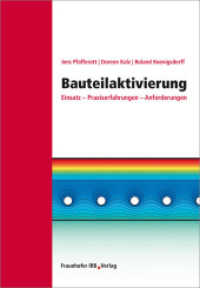- ホーム
- > 洋書
- > ドイツ書
- > Mathematics, Sciences & Technology
- > Technology
- > construction & environment engineering
Full Description
This book introduces the principles of modular construction, standardisation, flexibility and scalability and then demonstrates how they can revolutionise construction workflows, reduce project timelines, and enhance sustainability. Transforming the Built Environment: A Guide to Modular Construction Methodologies is a groundbreaking resource that redefines how buildings are designed, constructed and delivered. Packed with practical case studies, detailed illustrations and accessible explanations, this book bridges the gap between theory and practice, offering actionable insights for industry professionals, students and innovators. Whether you're an architect, engineer, contractor or policymaker, this book provides the tools and strategies to adopt modularity and stay ahead in an evolving industry. Discover how modular construction can optimise efficiency, improve quality, and contribute to greener, more cost-effective building solutions. Modularity Methodology is your ultimate roadmap to navigating and leading the future of construction.
Contents
Introduction To Modularity Methodology In The Construction Industry.- Modularity Methodology.- Theoretical Perspectives On Modularity Methodology.- Gaps In Modularity Methodology Theoretical Frameworks.- Global Perspective Of Modularity Methodology In The Construction Industry.- Conceptualising Modularity Methodology Model Adoption Framework.- Validation Of The Conceptual Framework.- Expert Opinions And Industry Insights Results.- Conclusion And Recommendation.








